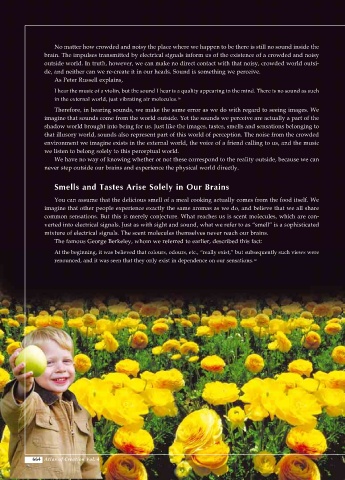Page 666 - Atlas of Creation Volume 4
P. 666
No matter how crowded and noisy the place where we happen to be there is still no sound inside the
brain. The impulses transmitted by electrical signals inform us of the existence of a crowded and noisy
outside world. In truth, however, we can make no direct contact with that noisy, crowded world outsi-
de, and neither can we re-create it in our heads. Sound is something we perceive.
As Peter Russell explains,
I hear the music of a violin, but the sound I hear is a quality appearing in the mind. There is no sound as such
in the external world, just vibrating air molecules. 59
Therefore, in hearing sounds, we make the same error as we do with regard to seeing images. We
imagine that sounds come from the world outside. Yet the sounds we perceive are actually a part of the
shadow world brought into being for us. Just like the images, tastes, smells and sensations belonging to
that illusory world, sounds also represent part of this world of perception. The noise from the crowded
environment we imagine exists in the external world, the voice of a friend calling to us, and the music
we listen to belong solely to this perceptual world.
We have no way of knowing whether or not these correspond to the reality outside, because we can
never step outside our brains and experience the physical world directly.
Smells and Tastes Arise Solely in Our Brains
You can assume that the delicious smell of a meal cooking actually comes from the food itself. We
imagine that other people experience exactly the same aromas as we do, and believe that we all share
common sensations. But this is merely conjecture. What reaches us is scent molecules, which are con-
verted into electrical signals. Just as with sight and sound, what we refer to as “smell” is a sophisticated
mixture of electrical signals. The scent molecules themselves never reach our brains.
The famous George Berkeley, whom we referred to earlier, described this fact:
At the beginning, it was believed that colours, odours, etc., “really exist,” but subsequently such views were
renounced, and it was seen that they only exist in dependence on our sensations. 60
664 Atlas of Creation Vol. 4

